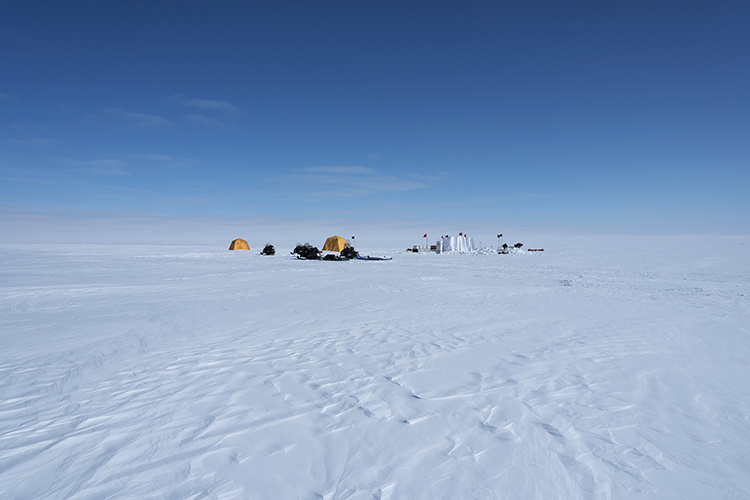
At the apex of the Greenland ice sheet, a community of 41 scientists and support staff carry out cutting-edge research into everything from climate change to particle physics
Words and photographs by Jean de Pomereu
For two hours, I had been sitting amid heavy cargo inside the hot, cavernous fuselage of a ski-equipped New York National Air Guard Hercules C-130. Other than the pilots, the aircraft carried just me, two loadmasters and Mike Jayred, a highly reputed ice-coring engineer who has spent the past two decades extracting some of the oldest and most precious climate records ever retrieved from Greenland and Antarctica. Any attempts at conversation were drowned out by the pressurisation, the roar of the propellor engines and our fluorescent earplugs.
As the plane came to a standstill after an almost unnoticeable landing on the snow runway, the loadmasters threw us our bags and frantically directed Mike and me to a small door at the front of the aircraft. The contrast couldn’t have been starker as we stepped out of the darkness and stumbled away from the deafening propellors as quickly as we could, disorientated by the brightness of the sun and reverberation on the snow. ‘Welcome to Summit’, shouted Hope from behind a cold-weather mask that protect her from the –30˚C temperature. She loaded our bags onto a sledge and directed us to the Big House. Propped up on ten-metre stilts, a big white radome on its roof and with the flags of the USA, Greenland and Denmark flapping in unison, the building was unmistakable as the station’s central hub.
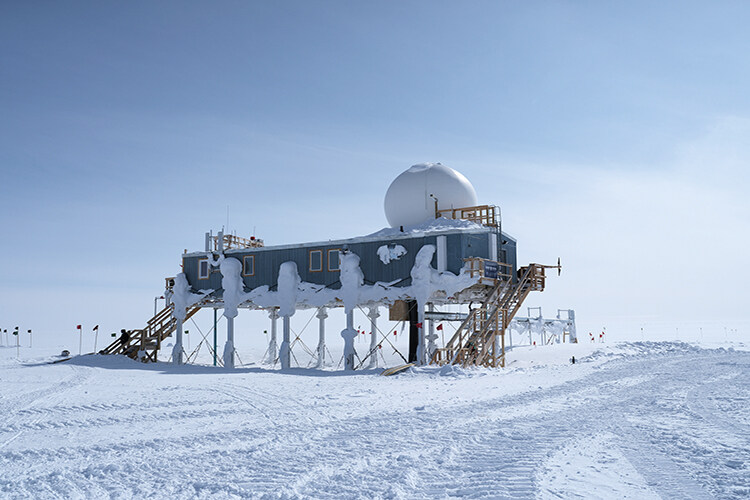
By the time we’d walked the couple of hundred metres to the Big House and climbed up the steps to its heavily insulated front door, Mike and I were both struggling for breath: a reminder, if needed, that Summit Station is located at an altitude of 3,200 metres, close to the apex of the Greenland ice sheet. Once inside, we were greeted by Austin, the station manager, and Diane, the doctor, who gave us a few moments to rest before our arrival briefing. We sat down at one of the dining tables lined up within a tight space that also comprised the galley, washroom, communications office and a couple of sofas for relaxing. With Pearl Jam blasting from the sound system and stores of US food brands stacked high on every available shelf, it definitely felt like an American outpost.
One of the large windows offered a good view of the station’s 17-hectare scattering of container-style sleeping structures, workshops, science labs, storage pallets, tracked vehicles of every kind and flag lines planted in different directions. Beyond that was the unbroken snow plain that characterised the ice sheet. Unlike that of a mountain, this summit offered no opportunity to look down at the valleys below. Instead, the frozen surface resembled that of an ocean, but one without any perceptible movement. Beneath our feet, the ice was more than three kilometres thick, and from here, it flowed only outwards. Covering an area three times the size of France, there’s enough ice to raise global sea levels by six to seven metres if it were to melt in its entirety.
What really struck me, however, was less the potential for catastrophe, as the luminescence of the ice. It was as if it was lit from within. The palest hues of blue, yellow and white dissolved into each other as they might in the most minimalist of abstract compositions. That so much beauty could be derived from so little visual information was breathtaking.
Station origins
The origin of Summit Station goes back to the late 1980s, when scientists from the US Greenland Ice Sheet Project (GISP2) chose the site to extract an ice core that would extend all the way from the surface to the bedrock beneath. For logistical practicalities, earlier deep ice cores had been extracted at military bases established on the ice sheet by the USA during the Cold War (the result of a strategic but still controversial agreement between the USA and Denmark, which governed Greenland at the time; today it’s an island autonomous territory of Denmark). Summit, on the other hand, was selected on purely glaciological grounds.
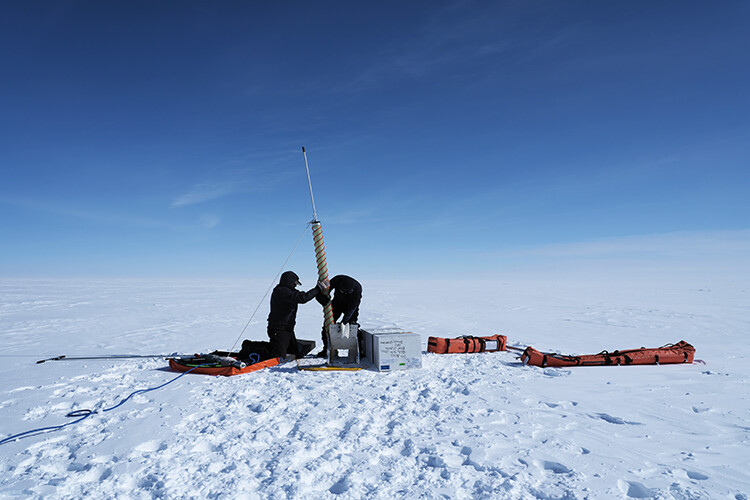
By drilling at the apex or ‘ice divide’ of the Greenland ice sheet, GISP2 scientists avoided any disturbances caused by glacial flow within the ice mass and obtained a 3,053-metre ice core that contained an undisturbed climate record going back more than 110,000 years. They were also able to compare this record with that of a separate ice core extracted by a European team during the same period just 28 kilometres to the east of Summit.
When GISP2 wrapped up in 1993 after five successful summer campaigns, the US National Science Foundation sought permission from the Greenlandic government to keep Summit Station open for continued scientific research focusing on both the ice and the atmosphere above it. Ten years later, in 2003, as the unique scientific value of the location only increased, the decision was taken to turn Summit into the year-round station that it remains today. Since then, the scope of research has increasingly focused on climate change, but has also made room for other fields, such as astronomy and particle physics.
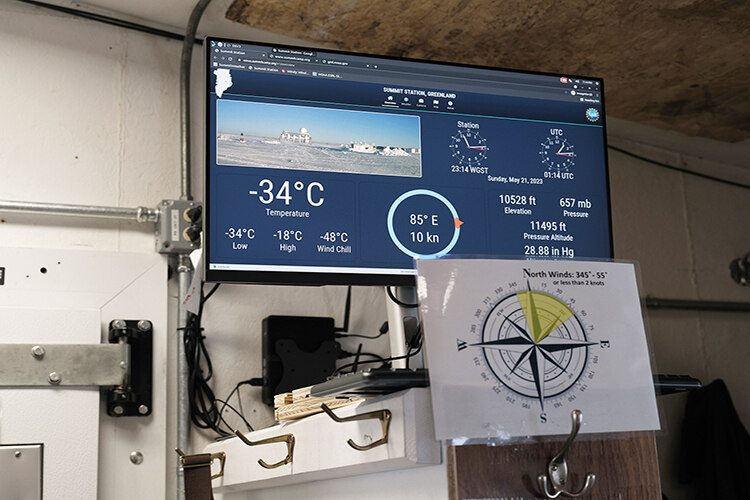
The community
With Mike and my arrival, the station had reached full capacity. We were now 42 souls living in close quarters, isolated from the nearest settlement by more than 400 kilometres. Among us, a third were researchers and the rest were the support staff required to operate the station. They included the cook (many would say the most important person on station); carpenters and other construction engineers; heavy-vehicle handlers in charge of moving cargo and clearing drift (a never-ending task), general support staff and a couple of technicians responsible for maintaining meteorological and other instruments installed by the scientists. Most of the support staff were employed by Battelle ARO, the private contractor that manages the station. Their stay at Summit ranged from six weeks to six months.
Although Marc, the head of construction, was British, all the other support staff were from the USA, many of them from northern states such as Montana, Washington and Alaska. Not only were they used to the cold and the snow, the majority of them also worked for the US Antarctic Program and had wintered in both the Arctic and the Antarctic. Ice, cold and community were their thing.

At Summit, despite a good internet connection, less time seemed to be wasted on the superfluous. Even if online shopping was a possibility, with the National Air Guard aircraft landing more than twice a week on average, people preferred to keep ‘stuff’ at bay. Despite the workload and the challenge of living at close quarters in such a harsh climate and in isolation, there was something protected about life at the station, which could make it challenging for people, especially winterers, to plunge back into the cacophony of the ‘real world’ when their contracts ended. How to renew them was a popular subject of conversation.
Here, at one of the most remote scientific stations on Earth, neither the specificity of each person’s work, nor the dedication with which it was carried out in any way lessened the spirit of teamwork and inclusivity. By which I don’t mean gender or racial parity – with just nine women and four minorities at Summit during my stay, these still fell short of parity – but rather the sense of shared purpose that was so important to the functioning of the station. The time window for getting things done, combined with the unpredictability of the weather, meant that everyone always seemed ready to lend a hand and to contribute much more than their contracted hours. This went from helping to carry up boxes of frozen food from the storage trench beneath the ice to washing up to sorting out technical glitches on atmospheric or astronomical instruments.
A few years back, it also meant taking turns to watch for polar bears after the mysterious appearance of a hungry individual that had travelled at least 400 kilometres from the coast and across the ice sheet to reach Summit. This was the first time that a bear had been seen this far inland, and despite repeated efforts to chase it off, it refused to retreat. There was no option but to fly in an authorised hunter to put it down. No more bears have been seen at Summit since.
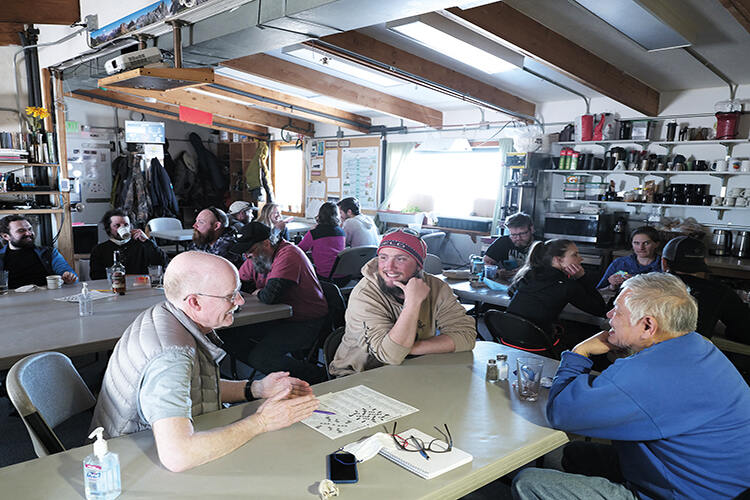
The science
Other than my own historical project focusing on how we came to explore and understand the Greenland and Antarctic ice sheets, there were four research groups working at Summit when I was there. This is about half the number of scientific projects usually deployed at the station over the course of a summer season. Two of the projects involved the extraction of shallow ice cores, the longest being 170 metres deep. Another focused on the observation and monitoring of clouds and the atmosphere. The fourth was a proof-of-concept experiment focusing on high-energy neutrinos, ‘ghost particles’ born of supernovas and other cosmic events.
In spending time at Summit, I was able to step away from papers and archives and experience first-hand just how challenging it remains to collect data from ice sheet environments. One example is the extent to which ice coring remains fraught with glitches and breakages that require technicians such as Mike to continuously rely on their instinct and many years of experience to keep projects on track. Or indeed how the repatriation of ice cores from the borehole to laboratories half a world away remains a logistical high-wire act where any interruption in the cold chain can result in the loss of years of work and planning.
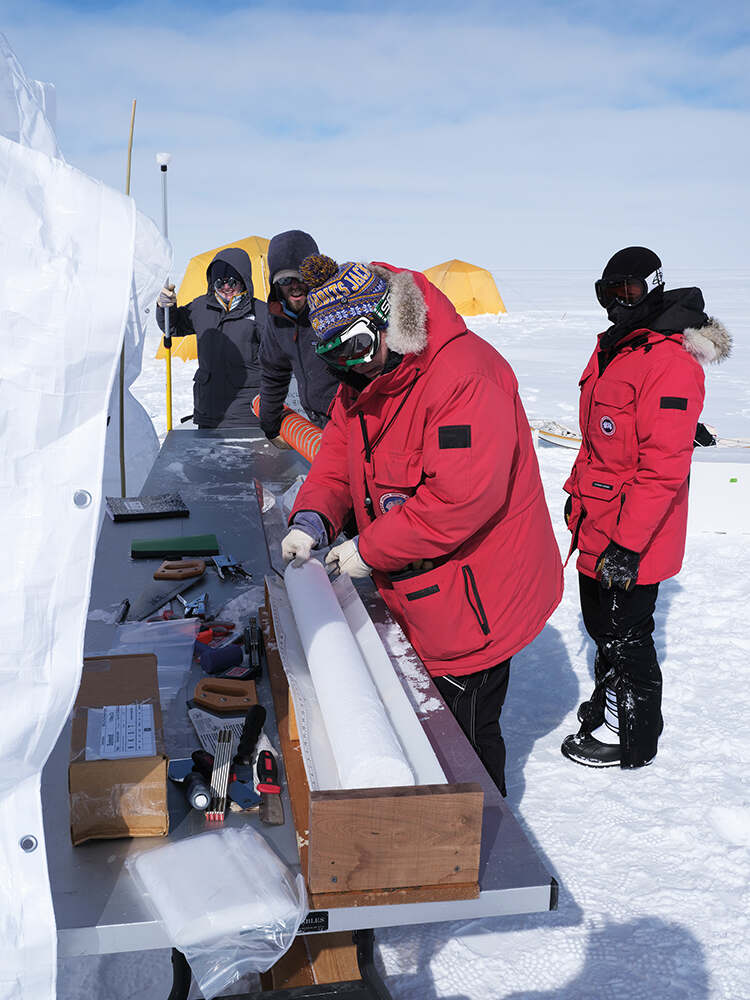
The first of the two ice-coring projects taking place at Summit was led by Becky Alexander from the University of Washington and Jihong Cole-Dai from South Dakota State University. Its aim was to extract a 15-metre core that Becky and her team will then analyse to map fluctuations in the concentration of sulphate aerosol within snow that fell on the ice sheet over the past 30 years. Because the sulphate present in the aerosol originates from the marine phytoplankton that grows beneath sea ice and constitutes the basis of the Arctic food web, this analysis will shed crucial light on the effects of retreating sea ice on the productivity of the entire Arctic marine ecosystem.
The other ice-coring project, to recover a 170-metre ice core, was led by Nathan Chellman and Joe McConnell from the Desert Research Institute in Reno, Nevada, in collaboration with Rachel Moore from the Georgia Institute of Technology and Ben Riddell-Young from Oregon State University. Joe is the architect of a pioneering laboratory designed to measure a broad range of elements contained within ice cores in quantities as small as a few parts per quadrillion. Thanks to his lab, Joe has been able to inform our understanding of both the shaping of human societies and the influence of humans on climate going back millennia. One striking example was the discovery that the concentration of lead pollution in Greenlandic ice cores corresponds with increases in the mining and smelting of lead and silver ores for coin and bullion production during the time of the Roman Empire. Another is that the spread of rice paddies and agriculture was already augmenting the atmospheric concentration of methane 5,000 years ago.
With this new ice core, Nathan and Joe plan to examine how ice-core chemistry could be affected by processes that occur during handling, storage and transport of the cores. Their findings are being watched very closely and will be highly significant for ice-core research going forward. Rachel Moore, on the other hand, will use the core to study bacteria and other latent biological entities once afloat in the atmosphere and now buried in the ice sheet. Her research will provide a window into the Earth’s environmental history and changing atmospheric patterns that goes back about six centuries.
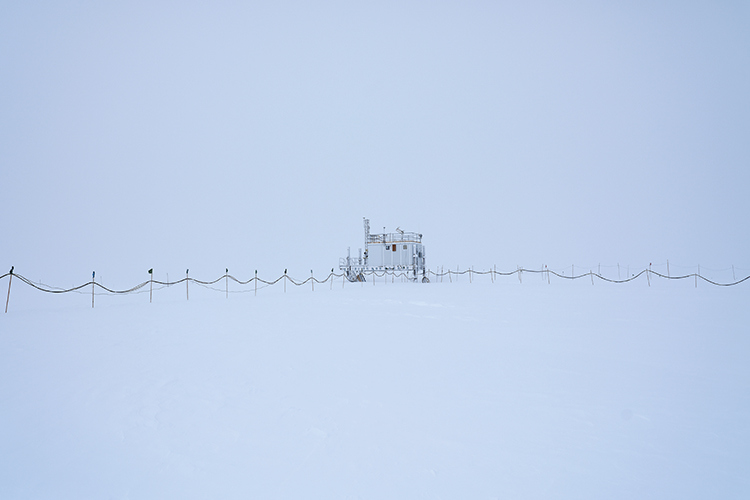
From the distant past to the almost timeless, the Radar Echo Telescope (RET) project, led by Steven Prohira from the University of Kansas and Krijn de Vries from Vrije Universiteit in Brussels, was the second and smaller of two astronomical experiments to be deployed at Summit during the past three years. In contrast to the Ice Cube neutrino observatory at the South Pole, which has cost US$300 million and counting, both Summit neutrino detectors have so far cost only a fraction of the price, relying on small but versatile installation teams – just five people in the case of RET.
With Prohira as their wide-eyed trailblazer, the RET team worked all hours to deploy their instrument and nearly had to be dragged away from it when their time came to fly out. Combining highly demanding fieldwork with the most abstract physics and questioning of the fundamental forces of the universe (the so-called Standard Model), RET encompassed the frontier spirit of Summit, where, thanks to Greenland’s greater proximity to the USA, concepts are often experimented with before being redeployed and expanded in Antarctica.
Where it comes to climate change and its future impact on the Greenland ice sheet, however, it’s the ICECAPS project and observatory that stand out for their long-term value and significance. A collaboration between five US universities and housed in a dedicated laboratory located some 300 metres from the Big House, ICECAPS was first established at Summit in 2010 and has since continuously added new capabilities to observe changes in cloud, atmosphere and precipitation properties at Summit.
This year, in addition to servicing existing instruments, Von Walden, a scientist from Washington State University who has worked many seasons in both Greenland and Antarctica, and Michael Gallagher, a highly creative young scientist from the National Oceanic and Atmospheric Administration, were testing a new autonomous and smaller-scale atmospheric laboratory that they hope to replicate and deploy in several new locations on the ice sheet.

of supplies and personnel
Equipped with smaller versions of the ICECAPS instruments, as well as a new device capable of directly measuring the effects of rising atmospheric temperatures on the uppermost metre of the ice sheet, the laboratory will record the interaction between atmosphere and ice, as well as the increasing number of melt events that are being observed at Summit and elsewhere across the ice sheet. Indeed, while ice cores have shown that high up on the Greenland ice sheet, temperatures have, on average, only risen above melting point once every 200 years, as many as four melt events have been observed at Summit since 1995 – or more than one every decade – with the first ever observed rainfall at Summit occurring in 2021.
Based on these and other findings, Von believes that the Greenland ice sheet is at an abrupt juncture in its history – one that will see its total melt rapidly increase in coming years and decades, and thus begin to significantly raise sea levels. For him, ICECAPS is about contributing a baseline from which future scientists will be able to measure change. This is to better understand the processes of melt, to which we’re all contributing, and whose unleashing we’re all about to witness.
New Summit
In the meantime, with the Big House showing its age and feeling evermore cramped, the National Science Foundation has launched a multi-year plan to replace it and all its surrounding buildings with a new, more integrated structure. Although the first stilts on which the new station will stand are already being delivered by Hercules C-130s, its exact design and layout remain uncertain. The most likely scenario is that it will comprise five interconnected buildings, each dedicated to a specific purpose, such as science, power generation, maintenance, living and sleeping.
While many will feel a sense of nostalgia for the Big House and the good times that it witnessed, the hope is that once built, the new Summit will be better equipped to keep expanding our understanding of our changing planet and its place in the cosmos: to generate knowledge and perhaps a little wisdom, too.




